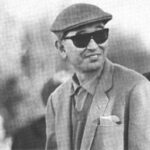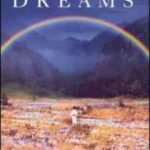Akira Kurosawa’s classic Rashamon is loosely based on two short stories by Ryuonsuke Akutagawa. The main story of the film is based on In the Grove while the film’s opening and closing scenes is from the short story, Rashomon. Like other novels or books that became films, there are naturally differences in the film and the stories since a film is an interpretation of an individual (in this case Akira Kurosawa ) and there are inherit limitations that prevents a film from accurately translating the story to the big screen.
The film uses the run down temple gate of Rashomon and the heavy rains as the backdrop of the story. This is the same setting used in the opening of the short story Rashomon. However, this is about as far as the film goes with that story. Instead of a servant sitting at the steps, a woodcutter and a Buddhist priest are sitting at the front gate. The two of them sit there with the look of disbelief. Moments later, a man comes in out of the rain and joins them under the shelter of the ruined gate. This man is used merely as a tool to get the men to introduce the story of In a Grove, this character does not exist in the original story.
The story, In a Grove, itself is not much of a story in the traditional sense, but more of a documentation of a trial involving the rape of a woman and a murder of a man. Witnesses and parties involved each give their own testimony of what happened and what they had seen with each person’s story being somewhat different. However, there is no resolve or verdict and the story simply ends with the testimony of the murdered man via a medium.
In the film, however, Kurosawa appears to have taken liberties in expanding the story and creating a straight forward beginning, rise, climax, fall and end. If he made the film verbatim, it would probably last fifteen minutes. Therefore, besides the opening scene, there are many significant differences in the film.
The first testimony of the woodcutter, which is presented to us in the film, he finds a a woman’s hat, a man’s hat, and an amulet case with red lining. However, in the original story, there is only a rope and a comb. Perhaps the purpose of having more items in the film, is to build anticipation in the audience when he encounters the dead body. Also, the items in the film are much more visually appealing than simply a rope and a comb.
The second testimony by the Buddhist priest is not very much different from the original story. Even his final statement “Truly human life is as evanescent as the morning dew or a flash of lightning.” is used in the film.
The policeman’s testimony is very different from the original story. In the original story, the bandit Tajomaru was caught on the bridge at Awataguchi while in the film, he was caught on the riverbank of Katsura. Also, Tajomaru was wearing a dark blue kimono, but in the film he was half naked. Perhaps his lack of clothing and wild looks enhanced the believability that he was a notorious bandit .
The film continues with the bandit explaining why he was off his horse. In the short story, the policeman simply stated that Tajomaru had fallen off his horse. But for comic effect, the Bandit explains that he drank bad water and had stomach problems as a result. This segues into Tajomaru’s confession and completely bypasses the testimony of the woman’s mother. The mother’s testimony does not appear to be very significant to the overall story, and would naturally break the rhythm of the film had it been interjected between the policeman’s testimony and Tajomaru’s confession.
Tajomaru’s confession in the film is basically the same as the short story but there are differences in the details. In the short story, he says he became their traveling partner and lured them into the mountains, then offered the man to sell some goods he had found. In the film, Tajomaru appears as an intimidating thug and simply confronts the couple and offers to sell the goods he had found. Also in the film, the man is simply tied up while the book has his mouth stuffed with leaves.
In the film, Tajomaru continued to tell his story by elaborating on the woman’s reaction when he told her that her husband was bitten by a snake (in the book, Tajomaru said the man had fallen ill). She then drew her sword and tried to attack him. In the short story, he managed to take her small sword away from her and proceeded to attack her. But to make it less disturbing and, maybe add a sexual edge to it, Tajomaru’s passionate kiss is what made her give up.
The film cuts back to the men at the temple. The unknown man acknowledges how bad a character Tajomaru is, and tells about the murder of two women at a temple during the previous year. This was mentioned in the testimony of the policeman in the original story. Then the Buddhist priest sets up the scene of the testimony of the woman who was attacked.
The film’s version of the woman’s testimony is very different from the original story. In the short story, the woman claims that she told her husband that she should kill him then kill herself. His mouth was stuffed with leaves but managed to say “kill me.” After she killed him, she removes the rope from his body then faints. The woman then awakens and she tries to kill herself using the dagger and throws herself into the river.
However, in the film, she tells a different story. As her husband looks at her in shame and disgust, she tries to get her husband to kill HER. She cuts the rope from his body and tries to hand her husband the knife. She screams “Don’t stare at me that way!” The woman then faints. She accidentally kills him as she falls. After the woman awakens and realizes she killed him, she runs away and tries to kill herself but fails.
The testimony of the murdered man in the original story does not change very much in the film version. Even the dialog is very similar. This testimony is the main attraction of the story. What is otherwise a simple story, the addition of the ghost gives this story an almost mystical nature. Therefore, any changes to this part for the film would lose the original feel of the short story.
Though the short story ends with the man’s testimony, with perhaps the intent for the reader to draw their own conclusion, the film continues with the woodcutter admitting that he witnessed the whole thing. While the short story used the rope as the prop of focus throughout everyone’s testimony, in the film, the missing dagger is used to lead up to the woodcutter’s account of the crime.
The woodcutter’s account is the resolve that is missing in the original story. By giving an unbiased view of what happened, it gives the viewer the satisfaction of knowing what actually happened. This may not be what Akutagawa intended but had this aspect of the story not been included in the film, the general film audience would be left confused. Of course this account is Kurosawa’s idea of what actually happened.
The testimonies and confession of each person showed the speakers in a favorable light. Their versions made the viewer feel sorry for each of them in one way or another. However, the woodcutter’s account showed how cowardly the men were and how insane the woman was, thus negating any sympathy that evolved over the course of the film.
The film goes back to the three men at Rashomon. This is perhaps the most powerful scene of the whole film. The missing dagger is the link that ties the story and the ending together. An argument ensues as the men discovers an abandoned baby. The unknown man tries to steal the child’s amulet and clothing but the woodcutter attempts to stop him. Angry, the unknown man shouts back saying that the parents are to blame for abandoning him. And he calls the woodcutter a hypocrite because he himself stole the dagger from a dead man. The woodcutter is ashamed.
The rain finally stops (symbolic of what happens next) and the woodcutter leaves, wanting to take the baby. The Buddhist priest, disillusioned by all that has happened, is quick to assume that the woodcutter is going to do something bad. Instead, the woodcutter wants to keep the baby, perhaps as a way of redeeming himself for his shameful deed or perhaps to make up for the selfishness of man. The priest is surprised and renews his faith in the goodness of man.
The film’s approach is different from the original story. Besides what was stated earlier, the film was also very atmospheric. There were several scenes of tense silence (ala Noh plays) and symbolic objects or actions (like the rain). Such mood, or any mood for that matter, is not conveyed in the short story. Therefore, though the film is based on In the Grove, one should view Kurosawa’s Rashomon as a stand alone film and not try to compare it to the original.





